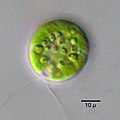Chlamydomonadales
| Chlamydomonadales | ||||||||||||
|---|---|---|---|---|---|---|---|---|---|---|---|---|

(A) Gonium pectorale , (B) Eudorina elegans , (C) Pleodorina californica , and (D) Volvox carteri |
||||||||||||
| Systematics | ||||||||||||
|
||||||||||||
| Scientific name | ||||||||||||
| Chlamydomonadales | ||||||||||||
| FE Fritsch |
The Chlamydomonadales (formerly Volvocales ) are an order of green algae . It encompasses flagellated and non- flagellated protozoa as well as filamentous and colony-forming forms. There are predominantly plankton organisms in fresh water. Flagellated species, which also include the colony-forming species, have two or four flagella per cell. The cell walls in non- flagellated forms consist predominantly of cellulose (as in plants), in flagellated forms of glycoproteins .
Single-celled species reproduce asexually by forming flagellated zoospores , which are formed by repeated division within the cell wall and then released. Sexually, they reproduce by forming two-flagged gametes of both sexes or unguided egg cells and flagellated spermatozoids . In the former case, the gametes of both sexes can look the same (isogamy), or the female ones are larger than the male ones (anisogamy).
Colonies are made up of linked flagellated cells. They can be tabular or spherical. In the most highly developed genus Volvox , a colony comprises several thousand cells and is to be regarded as a multicellular organism because only a small part of the cells is capable of reproduction.
All Chlamydomonadales are haplonts , i. H. with the exception of the zygote , all cells are haploid . The zygote is a permanent stage with a tough cell wall and is characteristically colored orange-red due to the inclusion of hematochromes . At this stage, these algae survive the drying out of their habitat.
The phylogeny of the Chlamydomonadales was only elucidated in recent years on the basis of genetic data. The very species-rich type genus Chlamydomonas , for example, turned out to be a polyphyletic collective group of at least eight lines that were not closely related and which, due to their simple morphology, had been wrongly regarded as belonging together. Some groups such as the previously differentiated order Volvocales have already been abandoned as non-monophyletic units. The previously differentiated orders Chlorococcales, Tetrasporales and Chlorosarcinales also turned out to be part of this subheading. The relationships within the Chlorophyceae are still uncertain because a large part of the taxa has not yet been sequenced. Possible sister group of the Chlamydomonadales is the order of the Sphaeropleales .
According to AlgaeBase , the following families with a total of more than 1600 species belong to the order:
| Families of the Chlamydomonadales | ||||||||||||||||||||||||||||||||||||||||||||||||||||||||||||||||||||||||||||||||||||||||
|
Species of the genus Dunaliella
literature
- Joachim W. Kadereit, Christian Körner, Benedikt Kost, Uwe Sonnewald: Strasburger Textbook of Plant Sciences . Springer Spectrum, Berlin / Heidelberg 2014, ISBN 978-3-642-54434-7 , pp. 593-595.
Individual evidence
- ^ Louise A. Lewis, Richard M. McCourt: Green algae and the origin of land plants. In: American Journal of Botany. 91 (10), 2004, pp. 1535-1556. doi: 10.3732 / ajb.91.10.1535
- ↑ Lingfang, Frederik Leliaert, Zhen-Hua Zhang, David Penny, Bo Jian Zhong: Evolution of the Chlorophyta: Insights from chloroplast phylogenomic analyzes. In: Journal of Systematics and Evolution. 55 (4), 2017, pp. 322-332. doi: 10.1111 / jse.12248
- ↑ Chlamydomonadales . In: AlgaeBase . AlgaeBase, accessed May 6, 2018 .



